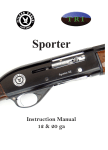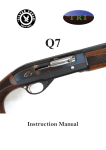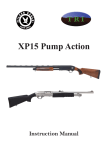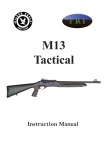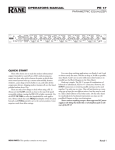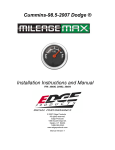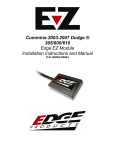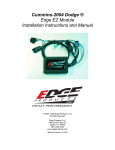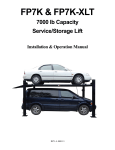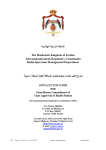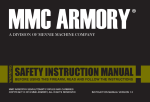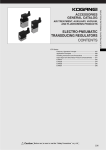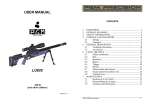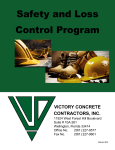Download 103DE and 103FE Over & Under Shotguns
Transcript
103DE and 103FE Over & Under Shotguns Instruction Manual ALWAYS KEEP THIS MANUAL WITH YOUR FIREARM. INCLUDE IT WITH THE FIREARM WHEN IT CHANGES OWNERSHIP. WARNING: ALL FIREARMS CAN BE DANGEROUS AND CAN CAUSE SERIOUS INJURY, DAMAGE TO PROPERTY OR DEATH. THE FOLLOWING SAFETY RULES ARE AN IMPORTANT REMINDER THAT FIREARM SAFETY IS YOUR RESPONSIBILITY. WARNING: READ THE ENTIRE MANUAL CAREFULLY BEFORE USING THIS FIREARM. MAKE SURE THAT ANY PERSON USING OR HAVING ACCESS TO THIS FIREARM READS AND UNDERSTANDS THIS ENTIRE MANUAL PRIOR TO USE OR ACCESS. WARNING: ALWAYS ENSURE THAT THE SAFETY IS FULLY ENGAGED UNTIL READY TO FIRE! NOTICE: The Manufacturer and/or its Official Distributors assume no liability for product malfunction or for physical injury or property damage resulting in whole or in part from criminal or negligent use of the product, improper or careless handling, unauthorized modifications, use of defective, improper, hand loaded, reloaded or remanufactured ammunition, customer misuse or neglect of the product, or other factors beyond manufacturer’s direct and immediate control. In addition to the Basic Safety Rules, there are other Safety Rules pertaining to the loading, unloading, disassembly, assembly and use of this firearm, located throughout this manual. WE RECOMMEND THE USE OF ORIGINAL SPARE PARTS AND ACCESSORIES. THE USE OF OTHER MANUFACTURERS’ SPARE PARTS AND ACCESSORIES COULD CAUSE MALFUNCTIONS AND/ OR BREAKAGES THAT WILL NOT BE COVERED BY THE SILVER EAGLE WARRANTY. 2 CONTENTS Page BASIC SAFETY RULES 4 NOMENCLATURE 7 DESCRIPTION 9 TECHNICAL FEATURES AND SPECIFICATIONS 10 ASSEMBLY & OPERATION 10 CHOKE TUBES 12 DISASSEMBLY 15 CARE & MAINTENANCE SERVICE & WARRANTY INFORMATION QUICK REFERENCE GUIDE - BACK COVER 3 18 19 BASIC SAFETY RULES CAUTION: READ THIS MANUAL CAREFULLY BEFORE USING THE SHOTGUN. CAUTION: FIREARMS CAN BE DANGEROUS AND CAN CAUSE SERIOUS INJURY, DAMAGE TO PROPERTY OR DEATH, IF HANDLED IMPROPERLY. THE FOLLOWING SAFETY RULES ARE AN IMPORTANT REMINDER THAT FIREARM SAFETY IS YOUR RESPONSIBILITY. 1. NEVER POINT A FIREARM AT SOMETHING THAT IS NOT SAFE TO SHOOT. Never let the muzzle of a firearm point at any part of your body or at another person. This is especially important when loading or unloading the firearm. When you are shooting at a target, know what is behind it. Slugs and shot can travel farther than their intended range. If you miss your target or if a projectile penetrates the target, it is your responsibility to ensure that the shot does not cause unintended injury or damage. 2. ALWAYS TREAT A FIREARM AS IF IT WERE LOADED. Never assume that a firearm is unloaded. The only certain way to ensure there are no cartridges in a firearm is to open the chamber and visually and physically examine the inside to see if a round is present. Removing or unloading the magazine will not guarantee that a firearm is unloaded or cannot fire. Shotguns can be checked by cycling or removing all rounds and by then opening and inspecting the chamber so that a visual inspection of the chamber for any remaining rounds can be made. 4 3. STORE YOUR FIREARM SO THAT CHILDREN CANNOT GAIN ACCESS TO IT. It is your responsibility to ensure that children under the age of 18 or other unauthorized persons do not gain access to your firearm. To reduce the risk of accidents involving children, unload your firearm, lock it and store the ammunition in a separate locked location. Please note that devices intended to prevent accidents - for example, cable locks, chamber plugs, etc., - may not prevent use or misuse of your firearm by a determined person. Firearm storage in a steel gun safe may be more appropriate to reduce the likelihood of intentional misuse of a firearm by a child or unauthorized person. 4. NEVER SHOOT AT WATER OR AT A HARD SURFACE. Shooting at the surface of water or at a rock or other hard surface increases the chance of ricochets or fragmentation of the bullet or shot, which can result in the projectile striking an unintended or peripheral target. 5. KNOW THE SAFETY FEATURES OF THE FIREARM YOU ARE USING, BUT REMEMBER: SAFETY DEVICES ARE NOT A SUBSTITUTE FOR SAFE HANDLING PROCEDURES. Never rely solely on a safety device to prevent an accident. It is imperative that you know and use the safety features of the particular firearm you are handling, but accidents can best be prevented by following the safe handling procedures described in these safety rules and elsewhere in the product manual. To further familiarize yourself with the proper use of this or other firearms, take a Firearms Safety Course taught by an expert in firearms use and safety procedures. 6. PROPERLY MAINTAIN YOUR FIREARM. Store and carry your firearm so that dirt or lint does not accumulate in the working parts. Clean and oil your firearm, following the instructions provided in this manual, after each use to prevent corrosion, damage to the barrel or accumulation of impurities which can prevent use of the firearm in an emergency. Always check the bore and chamber(s) prior to loading to ensure that they are clean and free from obstructions. Firing with an obstruction in the barrel or chamber can rupture the barrel and injure you or others nearby. In the event you hear an unusual noise when shooting, stop firing 5 immediately, engage the manual safety and unload the firearm. Make sure the chamber and barrel are free from any obstruction, such as part of a cartridge stuck inside the barrel due to defective or improper ammunition. 7. USE PROPER AMMUNITION. Use only factory-loaded, new ammunition manufactured to industry specifications: CIP (Europe and elsewhere), SAAMI® (U.S.A.). Be certain that each round you use is in the proper gauge and type for the particular firearm. The caliber or gauge of the firearm is clearly marked on the barrel. The use of reloaded or remanufactured ammunition can increase the likelihood of excessive cartridge pressures, case-head ruptures or other defects in the ammunition that can cause damage to your firearm and injury to yourself or others nearby. 8. ALWAYS WEAR PROTECTIVE GLASSES AND EARPLUGS WHEN SHOOTING. The chance that gas, gunpowder or metal fragments will blow back and injure a shooter who is firing a gun is rare, but the injury that can be sustained in such circumstances can be severe, including the possible loss of eyesight. A shooter must always wear impact resistant shooting glasses when firing any firearm. Earplugs and other high-quality hearing protectors help reduce the chance of hearing damage from shooting. 9. NEVER CLIMB A TREE, FENCE OR OBSTRUCTION WITH A LOADED FIREARM.. Open and empty the chamber(s) of your firearm and engage the manual safety before climbing or descending a tree or before climbing a fence or jumping over a ditch or other obstruction. Never pull or push a loaded firearm toward yourself or another person. Always unload a firearm, visually and physically check to see that the magazine, loading mechanism and chamber are unloaded, and action is open before handing it to another person. Never take a firearm from another person unless it is unloaded, visually and physically checked to confirm it is unloaded, and the action is open. 6 10. AVOID ALCOHOLIC BEVERAGES OR JUDGEMENT/REFLEX IMPAIRING MEDICATION WHEN SHOOTING. Do not drink and shoot. If you take medication that can impair motor reactions or judgement, do not handle a firearm while you are under the influence of the medication. 11. NEVER TRANSPORT A LOADED FIREARM. Unload a firearm before putting it in a vehicle (chamber empty, magazine empty). Hunters and target shooters should load their firearm only at their destination, and only when they are ready to shoot. If you carry a firearm for self-protection, leaving the chamber unloaded can reduce the chance of an unintentional discharge. 12. LEAD WARNING. Discharging firearms in poorly ventilated areas, cleaning firearms, or handling ammunition may result in exposure to lead and other substances known to cause birth defects, reproductive harm, and other serious physical injury. Have adequate ventilation at all times. Wash hands thoroughly after exposure. CAUTION: It is YOUR responsibility to know and abide by federal, state and local laws governing the sale, transportation and use of firearms in your area. WARNING: This firearm has the capability of taking your life or the life of someone else! Always be extremely careful with your firearm. An accident is almost always the result of not following basic firearm safety rules. For information about Firearm Safety Courses in your area, please visit the National Rifle Association’s web site at www.nra.org. BBarrels B1 Monobloc B2 Ejector B3 Ejector sear B4 Chambers B5 Ventilated rib B6 Fiber optic bead NOMENCLATURE B7 Muzzle B8 Barrel lump B9 Locking lump RReceiver R1 Side plates (103FE) R2 Top latch R3 Trunnions 7 R4 R5 R6 R7 R8 R9 SStock S1 Buttstock S2 Forend S3 Forend latch S4 Recoil pad T1 Trigger T2 Trigger guard Cocking bars Firing pins Safety/barrel selector Bolt release pin Standing face of breach Locking bolt 8 GENERAL DESCRIPTION HIGH CHROME-MOLY BARREL Barrels are bored from state-of-the industry solid bar C4140 German steel. Plated with hard chrome, they are fully compatible with steel and heavy shot. Lengthened forcing cones contribute to excellent pattern and recoil reduction. ANTI-GLARE RIB A full 10mm-wide rib promotes fast target acquisition. Reverse concave-ridged surface prevents glare, and fiber-optic front sight stands out in a wide variety of lighting conditions. Silver welded with 80,000lb tensile strength. STOCK Buttstock and forend are of beautiful Turkish walnut, hand-checkered with hand-rubbed oil finish. Soft recoil pad with hangup-free polished heel. Buttstock is cast-off and toed-out (reversed for LH models) for consistent and natural shouldering. METAL FINISH Receivers and all external surfaces, including trigger guard and forend latch, are beautifully engraved by hand, and finished with hard chrome plating for maximum corrosion resistance. External surface of barrels is hard black chrome, rendering them highly resistant to corrosion. SHELL REMOVAL Rugged and reliable auto ejectors eject fired shell, raising any unfired shell for easy removal by hand. TRIGGER SYSTEM Single-selective integrated safety and barrel selector permit selection of either barrel for first firing. Triggers are mechanically actuated, ensuring second shot in the event of a misfire of first shell. Solid steel sears and hammers are handpolished and fitted, ensuring reliable, crisp and consistent trigger pull. Free floating, spring-retracted firing pins are extremely durable and easily replaced. 9 TECHNICAL FEATURES AND SPECIFICATIONS Gauge Barrel Chamber Barrel Rib Front Sight Operation Locking System Receiver Safety Magazine Capacity Stock Length of Pull Drop Weight 12 76mm; accepts 23/4 and 3 inch shells C4140 chrome-moly steel with chrome-plated bore Ventilated, 10mm anti-glare Fiber optic Break-open Floor bolt and bifurcated lump C4110 steel Tang-mounted, integrated with barrel selector 2 shells Turkish Walnut 14.5 inches, + or - 1/4 inch DAC: 1.5” DAH: 2.25” 7lb 8oz (typical) OPERATION NOTE: numbers listed in the text refer to illustrations beginning on page 19. ASSEMBLING THE GUN Your shotgun is packed with the barrels separate from the stock and receiver. It is ordinarily stored disassembled in its case. WARNING: All assembly, disassembly and maintenance procedures should be carried out with the firearm unloaded. WARNING: During the assembly, disassembly and maintenance procedures, never point a firearm at someone or at hard and flat surfaces. Treat the firearm as if it were loaded. (See paragraphs 1, 2, and 4 of the BASIC SAFETY RULES). Assemble the barrels with the stock/receiver assembly as follows: 1. Open forend latch and remove the forend from the barrel (figs 1-2). 2. Push the top lever - full right - (opposite for LH models) until it latches. (fig 3) 3. Hold the barrel at an angle and pull it down into the receiver until the semicircular recesses on either side of the monobloc engage the trunnions on either side of the receiver. (fig 4) 10 4. Maintaining steady pressure to keep the monobloc and receiver engaged, rotate the barrel firmly upward to close. (fig 5) Note: it is normal for the top lever to be slightly off center when closed. This is because the locking block is a wedge, designed to firmly engage before reaching its full extension. This ensures a positive lockup even after many years of wear. 5. Insert the lower end of the forend into the receiver and rotate it firmly against the barrel until the latch is engaged. (fig 6) ENSURE THE FOREND LATCH IS COMPLETELY CLOSED BEFORE BREAKING OPEN THE GUN. OBSTRUCTION & CHOKE TUBE CHECK Check the barrels to ensure there are no obstructions in the chambers and bores. This is extremely important, because serious injury can result to the user or to nearby persons if a cartridge is fired in an obstructed barrel or chamber. Check the inside of the barrels prior to completely assembling the firearm and before use; if the firearm is already assembled the following procedure should be followed: • Move the top lever fully to the right (left for LH models) and open the shotgun. • Look right through the barrels from the rear and make sure there are no obstructions, even minor ones. • If an obstruction in a barrel is detected, a competent gunsmith must remove the obstruction. Reinspect the shotgun before firing. Check the condition of the choke tubes: • Make sure there is a choke tube installed! (See installation instructions, below). Shooting without a choke tube installed may irreparably damage the barrel! • Always check the appearance and cleaning of the choke tubes before using the shotgun. • Check correct tightness in the barrel with the wrench provided. • Never use choke tubes that show signs of defects, warping or incrustation. • Make sure that the choke tube inserted is appropriate for the intended use and shot type to be used (steel or lead). See “Ammunition”, below. • The application of a light coat of gun grease will make the tube easier to remove, and reduce the deposition of carbon between the tube and barrel. AMMUNITION WARNING: The manufacturer and distributor assume no liability for physical injury or property damage resulting from the use of defective, improper, handloaded, reloaded or remanufactured ammunition. Serious damage or injury, even death, may be caused by the use of ammunition that is not suitable, loaded with force, or loaded with obstructions in the barrel. 11 WARNING: Never use cartridges that do not correspond to the indications on the barrel. WARNING: Only use cartridges with a length equal to or less than the chamber length indicated on the barrel. WARNING: To avoid using improper ammunition, always check the characteristics stamped on the cartridge box and on the cartridge. Be sure to use the right cartridge gauge and length for your firearm. Your Silver Eagle shotgun is chambered for 3” and shorter shells. You will find markings for the gauge and chamber length on the side of the barrel. All Silver Eagle shotguns are tested with special proof test ammunition in accordance with government quality control standards. STEEL SHOT The barrel and choke tubes are designed for use with factory steel shot cartridges loaded to international standard specifications. When steel shot cartridges are fired, the best results are obtained by using open chokes (C, IC, M). Tighter choke constrictions, (IM, F) when using steel shot, do not increase pattern density and will accelerate wear and tear. The use of reloaded or remanufactured ammunition can increase the likelihood of excessive pressure, case rupture or other defects in the ammunition. CHOKE TUBES Silver Eagle choke tubes are similar to the popular “mobile chokes” used by many manufacturers, although compatibility with other brands cannot be assured. In addition to the choke tubes supplied with your gun and available from T R Imports as accessories, we recommend Trulock tubes (www.trulock. com) which have been manufactured in the USA to our specifications, and which are available in a wide variety of flush and extended models. CHOKE TUBE IDENTIFICATION Rim Notches I II III IIII IIIII Standard Designation F (Full) IM (Improved Modified) M (Modified) IC (Improved Cylinder) C (Cylinder/Skeet) 12 REMOVAL OF CHOKE TUBES WARNING: Always check that the shotgun is unloaded. Never look into the muzzle or change the tube of a loaded gun, even with the safety engaged. • Unscrew the choke tube by turning it counterclockwise using the supplied choke tube wrench (fig 24) and pull it out of the muzzle. CLEANING CHOKE TUBES • The choke tube interior is best cleaned by leaving it in place while cleaning the barrel, as described under ROUTINE MAINTENANCE, below. • After removing the choke tube, carefully clean the choke tube recess using a suitable solvent and, if necessary, a barrel brush. Dry it using a suitable gun cleaning patch. • Make sure the choke tube is perfectly clean inside and outside. It may be necessary to use a metal brush to remove heavy carbon deposits on the outside of the choke tube. INSTALLATION OF CHOKE TUBES • Apply a thin coat of gun grease to the outside of the choke tube and its threads. NOTE: using gun grease rather than oil will provide a better seal between the tube and the choke tube recess, minimizing carbon buildup and reducing the chance of a seized choke tube. • Insert the desired choke tube into the muzzle. Using the choke tube wrench provided, turn it clockwise until it has fully bottomed into the recess. WARNING: Periodically check that the choke tube is tightened correctly, first ensuring that the shotgun is unloaded. If necessary, firmly tighten the choke tube with the supplied choke tube wrench. Correct tightening of the choke tube is necessary to avoid shotgun damage or injury. WARNING: The choke must be kept correctly tightened in the barrel at all times,even during storage and cleaning. Cleaning the barrel without the choke tube installed may lead to dirt becoming lodged in the barrel thread and preventing the choke tube from screwing in properly, or to the formation of rust or obstructions. Keeping a choke tube installed at all times also improves the impact resistance of the muzzle end. WARNING: Never shoot without inserting a choke tube. Shooting without a choke tube in the barrel is very dangerous, as residues of lead or debris may become lodged in the thread creating an obstruction within the barrel. Also, not using a choke tube will damage the threading of the barrel irreparably and result in irregular shot spread. 13 LOADING AND FIRING WARNING: Before loading the firearm, it is a good idea to practice the following handling procedures without the use of ammunition. Never handle a loaded firearm until you are fully familiar with the loading procedures. Before loading the firearm, ensure that the safety is engaged. Always keep the firearm pointed in a safe direction. (See 1, 2 and 4 of the BASIC SAFETY RULES.) WARNING: The shooter and all bystanders must always wear protective eye wear and ear protection during shooting. Residue from gunpowder, lubricant or metal fragments may be projected backwards and cause injury. Noisereducing earplugs or earmuffs will reduce the risk of damage to hearing caused by prolonged shooting activity. WARNING: Always keep your finger off the trigger and avoid contact of other objects with the trigger if you don’t intend to fire. • Engage the safety by sliding the integral safety switch/barrel selector fully to the rear until the “S” is visible • With the safety on, slide it right to fire the bottom barrel first, or left for the top barrel. Barrel selection can only be made when the safety is engaged. (figs 7-8) • To cock the gun and ready it for loading, press the top lever completely to the right and force the barrel down, exposing the breach. As the gun is opened, the lever will remain latched. • Insert shells into the chambers, making sure they are fully seated against the ejectors. USE ONLY 3” OR SHORTER 12 GAUGE SHELLS. • Close the gun firmly. The top lever snapping to approximate center indicates the gun is properly locked closed and ready for shooting. WARNING: The firearm is now loaded and ready to fire after the manual safety is disengaged. Always keep your finger off the trigger and avoid contact with the trigger by other objects if you don’t intend to fire. Never point a firearm at something that is not safe to shoot. (See points 1, 2 and 4 of the BASIC SAFETY RULES). WARNING: When the “S” in front of the safety switch is not visible, the firearm is in the FIRE position. When ready to fire, keeping the gun pointed in a safe direction, slide the safety firmly and completely forward. Always keep the safety in the safe position until ready to fire. • After firing, release the trigger completely to reset the trigger for the next shot. 14 WARNING: After pulling the trigger, if the shotgun doesn’t fire, engage the safety, wait at least one minute and unload the shotgun as described in “UNLOADING THE FIREARM,” below. Never attempt to fire ammunition that did not fire the first time. Dispose of misfire or faulty ammunition properly in accordance with the cartridge manufacturer’s instructions. • Your gun is equipped with automatic ejectors; when you open the gun after firing, spent shells will be forcefully ejected. BEFORE OPENING, ENSURE THE EJECTORS ARE ANGLED AWAY FROM YOUR FACE. EMPTY SHELLS ARE EJECTED FORCEFULLY AND MAY CAUSE INJURY. Only fired shells are ejected; opening the gun will raise unspent shells to a height at which they may easily be removed. AFTER SHOOTING • When you have finished shooting, even if only temporarily, OPEN THE GUN. • Spent shells will be automatically ejected. Remove any live shells. This is the preferred safe carrying position for break-action shotguns. • When the firearm is available for use or is being transported, it should always be disassembled or left open. • For storage, it is recommended that tension be released from the hammer springs. Using the following steps: • After confirming that the gun is unloaded, close it. • Keeping the firearm pointed in a safe direction, disengage the safety and pull the trigger twice. (It is recommended that “snap caps” or dummy rounds be used to reduce wear on the firing pins.) • Engage the safety. DISASSEMBLY Beginning with an unloaded gun in the closed position, reverse the steps used to assemble the gun as follows: • Open the forend latch and remove the forend • Holding the gun firmly against your side while grasping the barrel with your opposite hand, press the top lever and open the gun carefully until the top lever latches open. CAUTION: WITH THE FOREND REMOVED, THE BARREL WILL SEPARATE FROM THE RECEIVER! • Remove the barrel. NOTICE: Further disassembly is not require for routine maintenance, and should be performed only by a qualified gunsmith. 15 • After removing the barrel, replace the forend, ensuring that the forend latch closes completely. Before storing the gun disassembled, we recommend that you release the tension from the locking spring as follows: • With the barrel removed, press the top lever further to the right (left, for LH models) of its latched position. • While holding the top lever in this position, which removes pressure from the bolt release pin (see nomenclature, above), depress the bolt release pin using your thumbnail or a flat object and allow the top lever to return to center. Clean and lubricate your shotgun any time combustion residue, grease or dirt have built up in any of the mechanisms. Cleaning and lubrication of the firearm after each use is the best way of ensuring that the components are protected against corrosion resulting from combustion residues or use in humid or salty environments. At the end of a shooting day, carry out the Routine Maintenance as described below. CARE & MAINTENANCE BARREL WARNING: Always check that the shotgun is unloaded. Inspect the firearm by breaking it open and looking through both barrels from the rear. • Carefully clean the inside of the barrel with a suitable gun cleaning patch and solvent to remove fouling and plastic residue deposited by shot cups. For heavy deposits, it may be necessary to use a bronze bore brush. NOTE: see CLEANING CHOKE TUBES, p. 14, above • When you believe you have removed all deposits, push a clean patch through the barrel. A clean barrel will have a mirror-like appearance. • Because the bore is plated with hard chrome, it is not necessary to oil it, but exposed steel areas, such as the chambers and muzzle end, should be left with a light coat of oil. Exterior barrel surfaces are plated with hard black chrome, and are highly resistant to corrosion. It is not necessary to oil them. • Check the barrel. The barrel and cartridge chamber must be clean and free of obstructions. WARNING: Excess oil or grease in the bore are dangerous when firing, and may damage the shotgun or injure the shooter or bystanders. Never apply lubricants to shot shells. 16 • Using solvent and a soft brush, remove any dirt or fouling from the ejectors and ejector sears • Dry and lightly oil the ejectors, ejector sears, and steel surfaces of the monobloc, including the gaps beneath the ejectors at the rear end of the chambers. Receiver and Forend • Remove powder residue from the standing face of the breach using solvent and a soft cloth or gun cleaning patch. Clean the receiver interior with a soft brush. Dry and lightly oil exposed surfaces. The application of a light coat of gun grease to the trunnions, forward end of the cocking bars, bolt, and the forend hardware will help ensure long life and smooth functioning of those components. 17 1 2 3 4 5 6 7 8 18 WARRANTY INFORMATION Firearms distributed by TRI carry a two-year limited warranty to the original purchaser for defects in materials or workmanship. If the original purchaser registers his firearm with TRI, he automatically receives an additional three years of warranty coverage for a total of five years. For more detailed information, please visit www.trimports.com/support. If you do not have access to the internet, call and we will assist you in registering your gun. HOW TO OBTAIN SERVICE For fastest service, contact us directly: T R Imports Inc Telephone: 817-750-2291 5778 Park Vista Circle Suite 302 Fax: 817-581-4222 Fort Worth, TX 76244 Email: [email protected] Web: trimports.com For questions, suggestions, or to discuss anything not covered in this manual, please call us, 9am-5pm Central, Monday-Friday. We thank you for the confidence you have shown in our products, and we look forward to hearing from you. Thank you! 19 Quick Reference Guide Ammunitionpage 14 Assembly page 9 Barrel Selectionpage 18 Disassemblypage 15 Service and Warranty: page 19 Specifications page 11 IMPORTANT NOTE: Before returning your gun to the retailer, contact TRI! Warranty Information 20 page 27




















